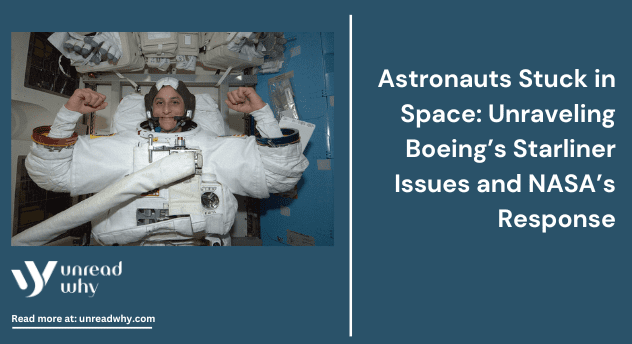Astronauts face uncertainty as Boeing’s Starliner encounters critical issues after its launch on June 5, 2024

In recent weeks, the Space community has been abuzz with news of NASA astronauts Butch Wilmore and Sunita Williams being unexpectedly extended on the International Space Station (ISS). Their mission abroad, Boeing’s Starliner capsule, has encountered several technical issues that have delayed their return to Earth. It has raised questions about NASA’s and Boeing’s preparedness and transparency.
What is the journey so far?
The Starliner mission, which is part of NASA’s Commercial Crew Program, was designed to test Boeing’s spacecraft capabilities. In the initial phases, they have planned for a brief 10-day stay, and the mission has now been extended multiple times because of some sort of technical challenges. Hopefully, the astronauts were scheduled to return by mid-June, but persistent problems with the spacecraft have pushed their return further in July.
Understand the technical hurdles.
On June 5, 2024, the Starliner launched from Florida’s Cape Canaveral Space Force Station. Within the first 25 hours, engineers identified five separate helium leaks along several thruster malfunctions, thus having observed to complicate the mission further. The Starliner says that, despite attempts to resolve these issues, a complete fix remains elusive. The spacecraft is designed to stay docked at the ISS for 45 days, which is a window that is rapidly closing.
The primary challenges plaguing Starliner involve its propulsion system and thrusters. As mentioned, the identification of helium leaks has been ascertained. The failure in the reaction control systems, which are essential for manoeuvring the spacecraft, has also occurred. These faults were discovered during the flight and subsequent docking attempts, which has raised concerns about the reliability of the organisations.
What are the responses NASA and Boeing have given?
NASA and Boeing have adopted a cautious approach, where they have decided to extend the stay of the astronauts on the ISS while engineers troubleshoot the faults. The extended mission provides additional time to assess the address the issues. On the flip side, it highlights the unpredictability of space missions that require careful pre-flight testing.

Mark Nappi, manager of Boeing’s Commercial Crew Program, is seen to acknowledge the challenges with the helium systems. He explains, “We have learned that our helium system is not performing as designed. We need to figure that out.” Hence, such admission underscored by popular figures in the space system reflects the gravity of the situation, as the thruster malfunctions have the possibility to jeopardise the safe re-entry and landing of the spacecraft.
Manager of NASA’s crew Program, named, Steve Stich, has also expressed his feelings on this, saying: “We thought we had fixed that problem. I think we are missing something fundamental that is going on inside the thruster.” Steve Stich’s statement indicates the complication and earnestness of the technical complexities facing the mission.
Safety concerns and transparency
The delays and technical issues have created a debate about the clarity/safety priorities of NASA and Boeing. Because of these challenges, space enthusiasts are now tracing the comparisons to past incidents, including the “Challenger and Columbia” disasters, as identified complexities were not addressed before the disastrous results. As per the reports of NASA and Boeing. This highlights the necessity for both organisations to prioritise crew safety over program milestones and certifications.

A contentious point is the decision to continue using Starliner for crewed missions despite unresolved technical issues. Some voices within the space community suggest using SpaceX’s Crew Dragon as a safer alternative for the astronauts’ return. Crew Dragon has more proven record of accomplishment, and it has completed successful missions, including Crew-1, Crew-2 and the recent Crew-7 mission (launched August 26, 2023 and returned March 12, 2024).
What are the expert opinions and organisational statements?
Jim Chilton, Senior Vice President of Boeing’s Space and Launch division, has stated, “We are committed to ensuring the safety of our astronauts and are working closely with NASA to resolve the issues. Our priority is to deliver a fully operational and safe spacecraft for the upcoming missions.”
NASA Administrator Bill Nelson also echoed similar sentiments: “Our teams are working around the clock to identify and rectify the problems with Starliner. We understand the concerns and assure the public that safety is our utmost priority.”

Contingency plans and return prospects
While the situation is not considered an emergency, NASA is taking extra precautions to ensure the spacecraft’s readiness for a safe return. Extensive tests on Starliner’s thrusters are being conducted at the White Sands Test Facility to replicate the problems experienced during the flight and confirm its reliability for re-entry.
In a worst-case scenario, either NASA has contingency plans to use a SpaceX Dragon capsule or a Russian Soyuz capsule to bring them home, though such measures are deemed unnecessary. The executive director of the space consulting group Astralytical, Laura Forczyk, has noted, “I don’t see this as being anything critical or life-threatening. I just think they are being extra cautious as they should be.”


